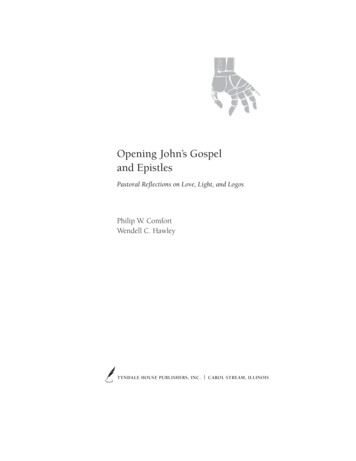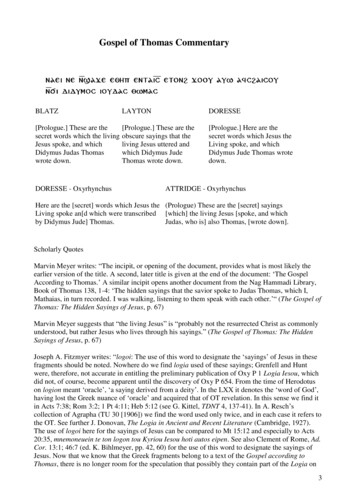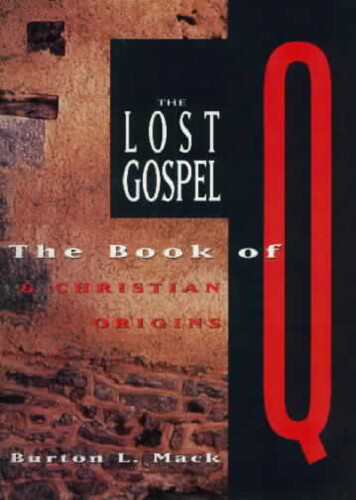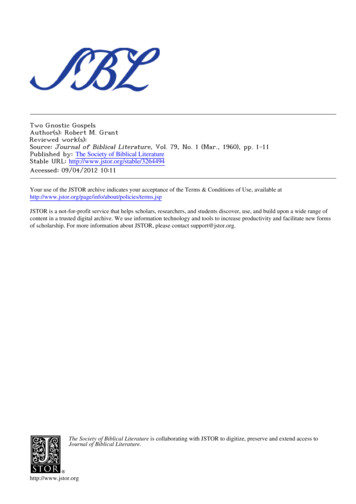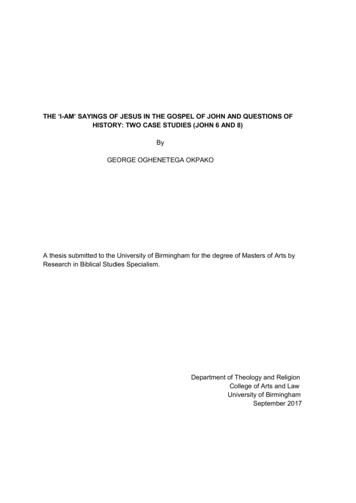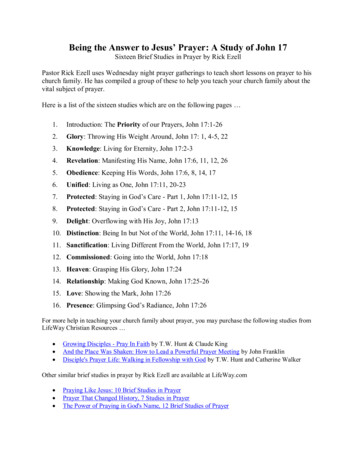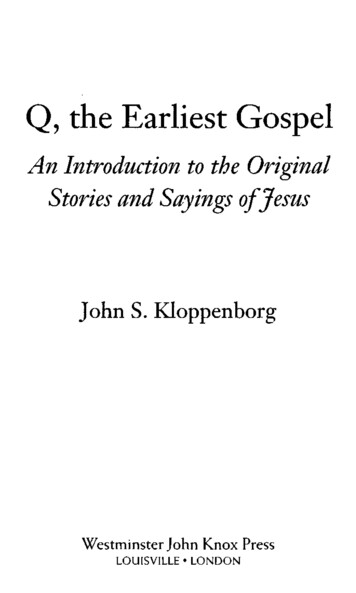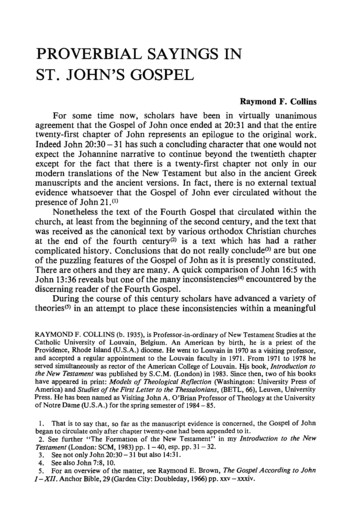
Transcription
PROVERBIAL SAYINGS INST. JOHN'S GOSPELRaymond F. CollinsFor some time now, scholars have been in virtually unanimousagreement that the Gospel of John once ended at 20:31 and that the entiretwenty-first chapter of John represents an epilogue to the original work.Indeed John 20:30 - 31 has such a concluding character that one would notexpect the Johannine narrative to continue beyond the twentieth chapterexcept for the fact that there is a twenty-first chapter not only in ourmodern translations of the New Testament but also in the ancient Greekmanuscripts and the ancient versions. In fact, there is no external textualevidence whatsoever that the Gospel of John ever circulated without thepresence of John 21. (1)Nonetheless the text of the Fourth Gospel that circulated within thechurch, at least from the beginning of the second century, and the text thatwas received as the canonical text by various orthodox Christian churchesat the end of the fourth century(2) is a text which has had a rathercomplicated history. Conclusions that do not really conclude(3) are but oneof the puzzling features of the Gospel of John as it is presently constituted.There are others and they are many. A quick comparison of John 16:5 withJohn 13:36 reveals but one of the many inconsistencies(4) encountered by thediscerning reader of the Fourth Gospel.During the course of this century scholars have advanced a variety oftheories(S) in an attempt to place these inconsistencies within a meaningfulRAYMOND F. COLLINS (b. 1935), is Professor-in-ordinary of New Testament Studies at theCatholic University of Louvain, Belgium. An American by birth, he is a priest of theProvidence, Rhode Island (U.S.A.) diocese. He went to Louvain in 1970 as a visiting professor,and accepted a regular appointment to the Louvain faculty in 1971. From 1971 to 1978 heserved simultaneously as rector of the American College of Louvain. Hjs book, Introduction tothe New Testament was published by S.C.M. (London) in 1983. Since then, two of his bookshave appeared in print: Models of Theological Reflection (Washington: University Press ofAmerica) and Studies of the First Letter to the Thessalonians, (BETL, 66), Leuven, UniversityPress. He has been named as Visiting John A. O'Brian Professor of Theology at the Universityof Notre Dame (U.S.A.) for the spring semester of 1984 -85.I. That is to say that, so far as the manuscript evidence is concerned, the Gospel of Johnbegan to circulate only after chapter twenty-one had been appended to it.2. See further "The Formation of the New Testament" in my Introduction to the NewTestament (London: SCM, 1983) pp. 1 - 40, esp. pp. 31 - 32.3. See not only John 20:30 -31 but also 14:31.4. See also John 7:8, 10.5. For an overview of the matter, see Raymond E. Brown, The Gospel According to JohnI - XII. Anchor Bible, 29 (Garden City: Doubleday, 1966) pp. xxv - xxxiv.
PROVERBIAL SAYINGS IN ST. JOHN'S GOSPEL43frame of reference. Some scholars have suggested that the author of theFourth Gospel made use of various documentary sources which have beenonly imperfectly incorporated into the present text. (6) Others haveconsidered that the present text of the Fourth Gospel results from a reordering of the original 10hannine schema. (7) Still others have held that theextant twenty-one chapter work is the product of a long history, in which wemust consider various stages in the oral tradition and successive redactionsof the written text. (8) All three of these approaches towards an explanationof the inconsistencies in the Fourth Gospel are to be found in recentmonographs and the best of the recent commentaries on the Gospel.Increasingly, however, scholars are of the mind that the Fourth Gospelwas produced within a "school"(9) and that the text of the Gospel was reedited at different moments in response to various situations within the1ohannine community. (10) The break of the 10hannine 1ewish Christiansfrom the synagogue would have been a major event in the life of thecommunity(\l) while the Christo logical debate within the community itselfwould represent another significant situation in its history. Detailed analysisof this history would take us far beyond the thrust of the present essay, butit is necessary for us to recall that the 10hannine community was acommunity very much alive at the time that the collection of Johanninewritings was composed, that this dynamic community lived through certainpressures from without and certain tensions from within, that thecommunity's theology developed(l2) because of these pressures and tensions,6. The classic proponent of this approach is Rudolf Bultmann who identified a signs source, arevelation discourse source, and an underlying passion narrative. See R. Bultmann, TheGospel of John. A Commentary(Oxford: Basil Blackwell, 1971), the original German text ofwhich appeared in 1940. The history of the possible use of a signs source by the evangelist hasbeen chronicled by Howard M. Teeple in The Literary Origin of the Gospel of John (Evanston:Religion and Ethics Institute, 1964) and Gilbert van Belle in De Semeia-Bron in hetVierde Evangelie. Onstaan en groei van een Hypothese (Louvain: University Press, 1975).7. See Bultmann's The Gospel of John, the order of which is laid out according toBultmann's theorizing in this regard.8. Among the recent major commentaries on John this approach has been adopted byRaymond E. Brown in The Gospel According to John I-XII; XIII-XXI. Anch ; r Bible 29, 29A(Garden City: Doubleday, 1966, 1970) and Rudolf Schnackenburg, The Gospel According toSt.John, Vol. I, Introduction and Commentary on Chapters 1-4 (New York: Seabury, 1980);Vol. 2, Commentary on Chapters 5 -12 (New York: Seabury, 1980); Vol. 3, Commentary onChapters 13 -21 (New York: Crossroad, 1982). In the German original the volumes wererespectively published in 1965,1971, and 1975.9. See R. Alan Culpepper, The Johannine School. An Evaluation of the Johannine-SchoolHypothesis Based on an Investigation of the Nature of Ancient Schools. Society of BiblicalLiterature Monograph Series, 26 (Missoula: Scholars Press, 1975).10. See especially Raymond E. Brown, The Community of the Beloved Disciple (New YorkRamsey: Paulist, 1979) and J. Louis Martyn, The Gospel of John in Christian History. Essaysfor Interpreters (New York-Ramsey: Paulist, 1978).II. In addition to the works cited in note 10, see also J .L. Martyn, History and Theology inthe Fourth Gospel (2nd. rev. ed.: Nashville: Abingdon, 1979).12. Perhaps it may be more correct to say that it occasionally jumped forward in quantumlike leaps.
44RAYMOND F. COLLINSand that the pressures and tensions, along with the responsorial theologywhich they evoked, are reflected in the community's literature. The present,somewhat confused state of the Gospel of John, reflects the development,under pressure, of the Johannine community. The Fourth Gospel wasamended as the community which produced it evolved.An examination of John 21 reveals that the entire chapter focuses onSimon Peter but that the figure of him which emerges from John 21 is somewhat different from the Simon Peter discovered by the reader of John 1 20.This difference of characterization is but one of the many inconsistenciesthat exist between John 21 and the rest of the Gospel of John.(l3) One couldalso note that the phrase with which the chapter begins, "After this" (metatauta), is a classic example of a loose connective;(l4) but it hardly fits afterthe definite conclusion found in John 20:30 - 31. Moreover, verses 1 and 14frame John 21: 1 - 14 in such a manner that one must consider themiraculous catch of fish and the breakfast by the sea to constitute but asingle story in the present J ohannine account. (lS) Verse 14 indicates that thenarrative describes the third manifestation of the Risen Lord to hisdisciples, in apparent oblivion of Jesus' appearance to Mary Magdalen.(16)In addition to these various inconsistencies, there is the salient fact that theGospel has been brought to a clear and classic conclusion in 20:30 - 31 andthat the story has been reopened as chapter twenty-one begins.In sum, the internal evidence offered by an examination of John 21coalesces with contemporary theories about the history of the Johanninecommunity, to lead virtually all scholars to the conclusion that John 21represents a rather late addition to the written Gospel of John. Thematicallyit focuses not only on Peter but also on a number of ecclesiastical issues,especiall Jesus' presence at a meal. (17) These foci suggest that John 21 wasadded to an earlier edition of the Gospel in order to address issues bearingupon the relationship between the J ohannine community and otherChristian churches. In this way John 21 functions as a reflective postscriptto the body of the Gospel. (18)John's Gospel stands out among the four canonical Gospels because ithas an epilogue and a prologue which were appended to the written Gospelat a relatively late stage in its literary history. It may well be and indeed it is13. For an overview of some of these differences, see Ernst Haenctien, John 2. Hermeneia(philadelphia: Fortress, 1984) p. 229.14. In John it is found at 3:22; 5:1,14; 6:1; 7:1; 19:38; and 21:1; see also the use of meta toutoin John2:12; 16:7,11; 19:28.15. The narrative framework is a classic example of indusio (ring construction).16. John20:1,1l 18.17. See R. Schnackenburg, The Gospel According to St.John, VoL 3, p. 409 and PhemePerkins, Resurrection: New Testament Witness and Contemporary Reflection (Garden City:Doubleday, 1984) p. 180;.18. A clear indication that John 21 serves as a reflection on the body of the Gospel is the factthat the triple scrutiny and triple commission of Peter (John 21:15 -17) is linked to the tripledenial of Peter (John 18:17 ,25,27).
PROVERBIAL SAYINGS IN ST. JOHN'S GOSPEL45likely that John 21 was added to the Gospel at the same time as the prologue(John 1:1-18). Nonetheless there is a marked difference between thefunction and style of the prologue and the function and style of theepilogue.Functionally, the prologue puts the Johannine Gospel and its Christ,the central focus of the Gospel narrative, in the broadest possibleperspective. It serves as a broad commentary on the Gospel, enabling thereader to focus attention sharply upon the central concerns of the writtenwork.(19)Stylistically, the prologue consists of an interweaving of poetic andnarrative elements. Its language is clearly different from the language of theGospel itself.(20) The stylistic and linguistic differences between the prologueand the body of the Gospel have led many commentators - perhaps themajority(21) - to opine that the prologue is a reworking of an earlier Vorlagewhich was probably composed outside the Johannine community.Functionally, the epilogue is a reflection on the traditions of the otherChristian churches(22) from the perspective of the Johannine community.Stylistically, the dialogue technique and the characterization of the disciplesreflects that of the body of the Gospel. Linguistically, even though there areseveral J ohannine hapax legomena in the chapter, (23) John 21 echoes thevocabulary of the main part of the Gospel itself. Indeed the style andlll.nguage of the epilogue is such that one must unquestionably affirm that ithas been composed within the Johannine community. Moreover, thecitation of seven disciples in John 21:2 serves as an indication that thetraditions which have been set down in writing in the epilogue circulatedwithin the Johannine community.Given this situation it might be well to characterize the style andvocabulary of the epilogue as an imitative style and vocabulary. The authorof this chapter has consciously aped the style and vocabulary of a previouslyextant twenty-chapter work with which he was quite familiar. The imitationof style afld vocabulary is all the more striking in that the themes of John 21are not themes which have appeared in the main part of the Gospel - aseaside appearance to Simon Peter and the other disciples, fishing, a meal19. See my article, "The Oldest Commentary on the Fourth Gospel," The Bible Today 98(I978) 1769 - 1775.20. Not the least of these differences is the use of Logos, "the Word" in vv.1 and 14. Theterm does not appear as a proper noun in the body of the Gospel.21. The tendency to interpret the prologue as a later edition of an earlier Vorlage isparticularly pronounced in German-language scholarship. By way of example, we can cite thecommentary on the prologue in the works of Haenchen (John 1, Philadelphia, Fortress, 1984)and Schnackenburg (see above, note 8) as well as articles on the topic written by these authorsin various scholarly journals.22. Especially the "apostolic church" associated with the Twelve.23. In v.2, for example, we find a partitive apo ("from") instead of ek and the "sons ofZebedee" (hoi huioi Zebedaiou).
46RAYMOND F. COLLINSof bread and fish, the Petrine commission, and death. In the epilogue thesenon-J ohannine themes are treated in a very J ohannine manner.Chapter twenty-one's technique of the dramatic sequence of successivelittle scenes is very Johannine. (24) It recalls not only the drama that followedupon the cure of the blind man (John 9), but also the call of the firstdisciples (John 1:35 51) and the story of water-become-wine at Cana inGalilee (John 2:1 12).(25) Stylistically, as has been noted, the dialoguetechnique is a typical ploy of the evangelist which has been imitated by thestory-teller who has appended John 21 to the earlier narrative.(26) The interrogations in John 21, the questions and repeated questions found within thedialogue, recall the evangelist's predilection for interrogation as a literarydevice. (27)As far as the characters who appear in the epilogue are concerned, thereader must surely note that Peter is called Simon Peter as he is throughoutthe Gospel. In direct address, Jesus calls him "Peter, son of John"(vv.15, 16,17). The formula calls to mind the words of Jesus in John 1:42.(28)Thomas is identified as the Twin (John 21:2), just as he is in John 20:24. Inthe epilogue the Beloved Disciple is identified as the one who had lain onJesus' breast at the supper (v.20). In this presentation the author of theepilogue has portrayed the Beloved Disciple by means of a salient feature, (29)just as the evangelist himself had typified Andrew as the brother of SimonPeter, (30) Nicodemus as the one who had come by night, (31) Judas as thebetrayer, (32) Lazarus as the one who had been raised, (33) and Mary ofBethany as the one who had annointed and wiped Jesus' feet. (34)John 21:18The fact that the author of the epilogue so consciously imitates the styleof the author of the Fourth Gospel brings into sharp focus the techniqueemployed in his story-telling at John 21: 18 19a. The passage lies within a24. See especially J.L. Martyn, History and Theology.25. See my "Cana (In. 2:1 12)The First of His Signs of the Key to His Signs?" IrishTheological Quarterly 47 (1980) 79 - 95, esp. p. 82.26. See, for example, the dialogue with Nicodemus in John 3: 1 11.27. See Albert Vanhoye, Interrogation johannique et exegese de Cana (In. 2,4), "Biblica 55(1974) 152-167, esp. pp. 157 -158.28.There is however a difference between the two formulae. In John 1:42 we find Simon hohuios Ioannou (literally, Simon, the son of John), the equivalent of Matthew's Aramaic SimonBar-Jona (Matt 16:17); whereas in John 21:15,16,17 we have an elliptical Simon Ioannou(literally, Simon of John).29. See John 13:23,35.30. See John 1:40 in comparison with John 6:8.31. See John 7:50 and 19:39 in comparison with John 3:1.32. See John 6:64,71 and 12:4 in comparison with John 13:31 - 30; 18:2.33. See John 12:1,9 in comparison with John 11:43 -44.34. See John 11:2 in comparison with John 12:3
PROVERBIAL SAYINGS IN ST. JOHN'S GOSPEL47pericope which sets in comparative contrast the figures of Simon Peter andthe Beloved Disciple. This follows the example of the evangelist himselfwho similarly contrasted Peter and the Beloved in John 13:22 - 26;18:15 -18; and 20:2-10. The pericope begins with the formulaicexpression "Truly, truly I say to you" (amen amen lego soi,v.18), a formulafound only in John's Gospel and used by the evangelist to indicate that he ismaking reference to a traditional logion of Jesus albeit in his ownfashion. (35) Moreover, the reflective thought contained in v .19a not only hasthe character of the Johannine note(36) but also recalls John 12:33 whereJesus is presented as indicating the death by which He himself was to die.Just as Peter succeeded Jesus in the shepherding of the flock, so he wouldsucceed him in dying the death on the cross. (37)The "follow me" of v.19b has, in fact, a rather profound significance.On one level, it has a narrative function insofar as the story-teller is relatinga tale of Jesus' being followed by Simon Peter with the Beloved Disciple, asit were, chasing after them. (38) Nonetheless Jesus' invitation to Simon Peterhas yet a deeper meaning. Peter was to follow Jesus not only as the onceonly conclusion to the narrated occurence, but also in shepherding the flockand dying" the martyr's death. Thus the story-teller's use of "follow me" inv.19b recalls the evangelist's double-level technique. His words often havesignificance on the symbolic level in addition to their significance on thenarrative level. (39)These several points make it quite clear that the story-teller is imitatingthe style of the evangelist as he narrates his tale in 21: 18 - 23. The talebegins with the classic Johannine lemma, "Amen, amen I say to you," andthen Jesus addresses an enigmatic statement to Peter: "When you wereyoung, you girded yourself and walked where you would; but when you areold, you will stretch out your hands and another will gird you and carry youwhere you do not wish to go." The utterance consists of three pairs ofcontrasting statements: 1) when you were young - when you are old; 2) yougirded yourself - you will stretch out your hands and another will gird you;3) you walked where you would - another will carry you where you do not35. See Barnabas Lindars, The Gospel of John. New Century Bible (London: Oliphants,1972), p. 48; and "John and the Synoptic Gospels: A Test Case" New Testament Studies 27(1981)287 -294.36. See John J. O'Rourke, "Asides in the Gospel of John," Novum Testamentum 21 (1979)210-219,37. The tradition that Peter was crucified head downwards, found in the apocryphal Acts ofPeter and referred to by Eusebius, represents a much later embellishment.38. See v.20.39. J. Louis Martyn has called attention to this technique in his History and Theology.Important hermeneutical reflections on its significance are to be found in Xavier Leon-Dufour,"Towards a Symbolic Reading of the Fourth Gospel," New Testament Studies 27 (1981)439-456, and Sandra M. Schnieders, "History and Symbolism in the Fourth Gospel," in M.de Jonge, ed., L'Evangile de Jean: Sources, Redaction, Theologie. Bibliotheca EphemeridumTheologicarum Lovaniensium, 44 (Louvain: University Press, 1977) pp. 371 - 376.
48RAYMOND F. COLLINSwish to go. A number of authors have suggested that the story-teller hasmade use of an ancient proverb(40) which contrasts the vibrancy andautonomy of youth with the inertness and passivity of those who have diedin old age. (41) That the youth goes where he wants while the body of a deadman is carried to the grave is the reflection of the anonymous sage. Such astatement of gnomic wisdom is a truism which the story-teller has employedas he attempts to reflect respectively on the deaths of Simon Peter and theBeloved Disciple.The traditional utterance did not specify any particular type ofdeath;(42) it merely contrasted life and death. The story-teller, however, wasinterested in reflecting on Peter's death by crucifixion - a historical factwhich had occurred well in the past when John 21 was set to writing.Accordingly he interpolated into the traditional proverb the middlecontrast, girded - being girded. Peter's girding himself recalls his impetousaction in girding himself before jumping into the water (v. 7). His beinggirded may well recall the death shrouds which encompass the body of onewho has died and is being carried out for burial. In any case, however, themention of Simon Peter's "stretching out his hands" (ekteneis tas cheirassou) interrupts the balance of the expanded proverb. It recalls the languageused by classical and Christian authors in antiquity to describe the handsthat are stretched out and tied to the beam of the cross prior to one's beingled out to crucifixion. (43) In short, the story-teller has adapted an ancientproverb to his own ends by inserting a third contrast in the midst of thetraditional contrasts. By doing so, he has applied the proverb to thesituation of Simon Peter who died by crucifixion. Thereby he prepared theway for his own explanatory note, "This he said to show by what death hewas to glorify God" (v. 19a).The story-teller'S use of an old proverb in this fashion is not onlyinteresting in itself; it is also interesting because it is an indication that the40. Bultmann has observed that "v. IS is a prophecy by parable, at the base of which clearlylies a proverb" (op. cit., p. 714). His suggestion has received the warm endorsements of C.K.Barrett, Ernst Haenchen, Barnabas Lindars, and Rudolf Schnackenburg in their respectivecommentaries. Bultmann reconstitutes the proverb as something like "In youth a man is freeto go where he will; in old age a man must let himself be taken where he does not will."41. According to Bultmann, the proverb points to the helplessness of the old man whostretches out his hands while groping for a support or for someone to lead him. See R.Bultmann, op. cit., p. 713, n. 7; p. 714, n. 1. More persuasive, in my view, is the argumentation of Haenchen who notes that" 'Taking someone where he or she does not want togo' refers to the grave. The combination of old age and death is not uncommon." See E.Haenchen, John 2, p. 226.42. Bultmann not only argues that the reworked proverb does not specify death bycrucifixion but also that the proverb refers simply to old age. Thus "the proverb needs theexplanation" ofv.19a. See R. Bultmann, op. cit., p. 714, n. 1.43. Among others, Epictetus, Artemidorus, and Plautus; Josephus; Ep. Barnabas andTertullian. See Barnabas Lindars, op. cit., pp. 636-637, and E. Haenchen, John 2, pp.226-227.
PROVERBIAL SAYINGS IN ST. JOHN'S GOSPEL49use of proverbs(44) was one of the features of the Gospel which so caught thefancy of the story-teller that he was prompted to imitate it when hecomposed his epilogue. This is indeed striking because the evangelist's useof proverbs seems not to have particularly captivated the attention oftoday's scholars. There is, nonetheless, a significant number of proverbsscattered throughout the Fourth Gospel. These proverbs have been variouslyadapted by the evangelist to suit his own purposes. His way of dealing withancient proverbs has been imitated by the story-teller responsible for John21; perhaps it could also serve as a lesson for Christian story-tellers in ourtimes.John 2:10The first proverb incorporated into John's Gospel is found in John2: 10, "Every man serves the good wine first; and when men have drunkfreely, then the poor wine." Although there are no clear parallels to thisproverb in extra-biblical literature, the saying seems to enjoy a proverbialcharacter. (45) It speaks of a common situation, generically citing"everyone" (literally, every man, pas anthropos) as the subject of theutterance. Strictly speaking it does not even fit easily into the J ohanninenarrative. In the social context to which John 2:1-11 refers, the statementis not particularly appropriate since wedding festitivities were spread overseveral days. They were characterized by that coming-and-going which isstill to be found in oriental gatherings. In such a situation late-comerswould have been unable to compare the wine served to them with the wine44. With Bultmann, I would describe a proverb as a "saying of popular wisdom." See R.Buitmann, The History oj the Synoptic Tradition (New York: Harper & Row, 1%3), n. 38, n.2. The proverb is characterized by its appeal to common human experience, its brevity, its useof generic utterance, and the present tense or gnonmic aorist. The proverb (stich wort) is to bedistingnished from the similitude (bi/dwort), even though a proverb may be used forcomparison's sake. The latter is frequently the case in John's use of proverbs. His proverbs areoften used allegorically. Thus it is often difficult to distinguish between proverbs and smallparables in the Fourth Gospel. The proverbs frequently function as small parables.45.Both Strack-Billerbeck and, following Hans Windisch, Bultmann indicate that thecommon practice of first century Palestine was otherwise. See H.L. Strack-Po Billerbeck,Kommentar zum Neuen Testament aus Talmud und Midrasch, Vol. 2 (Munich: Beck, 1924) p.409; and R. Bultmann, The Gospel of John, p. 118, n. 4. Econtrario, F.F. Bruce commentsthat "the common practice was so well known as to be proverbial." See F.F. Bruce, TheGospel oj John (Grand Rapids: Eerdmans, 1983) p. 71.Recognizing that v.1O represents a "detached saying" (The Gospel oj John, p.13I),Barnabas Lindars speaks of it as "a relic of an authentic parable of Jesus" (p. 319) and aparable derived from traditions of the words of Jesus (p. 32) in "Two Parables in John," NewTestament Studies 16 (\ 970) 318 - 329. These different observations recall that not only arethere frequently no extant extra-biblical parallels to the Johannine proverbs but also that asthey are presently found in John the proverbs are worded according to a Johannineformulation. Accordingly the characterization of a Johannine logion as a proverb (orreworked proverb) must be based on an analysis of the literary form of the saying in question.
50RAYMOND F. COLLINSserved to the first set of guests. Moreover in its specifically Johanninecontext the logion is not particularly appropriate since the pericope contraststhe absence of wine with the abundant quantity provided by Jesus. Themiracle story from which the Johannine narrative was fashioned focused onthe quantity of wine; the proverb focuses on the quality of the wine.This doubly inappropriate character of the logion serves to indicatethat the evangelist has borrowed a saying from elsewhere. Nonetheless hehas deliberately introduced the proverb into his narrative because it serveshis purpose. One of the major concerns of the evangelist is to contrast theold dispensation (Judaism) with the new dispensation inaugurated by Jesus.The theme is interwoven throughout the Fourth GospeL In his reworking ofthe miracle story of the water-become-wine the evangelist not only indicatedthat Jesus is the provider of the expected messianic blessings in abundance,but also that what Jesus has come to bring contrasts sharply with that whichhad been suitable up to the time of Jesus' comingthe various institutionsof Judaism which are ineffective in comparison with the gifts of Jesus.John 3:8Another proverb used by the evangelist is to be found in John 3:8where the words' 'The wind (pneuma) blows where it wills, and you hear thesound of it, but you do not know whence it comes or whither it goes" areattributed to Jesus. In its Johannine context the proverb functionsmetaphorically(46) insofar as pneuma can denote either the wind or thespirit.(47) The point of comparison would seem to be either the freedom ofmovement of the wind/spirit or its incomprehensibility.(48) Once again,however, the proverb does not appear to be entirelY apropos in itsJohannine context. On the one hand, the evangelist has retained theproverb's statement on the sound of the wind, but he has not exploited it inhis use of the proverb. Moreover the application to one born anew is notentirely appropriate. Indeed the Johannine phrasing of the proverb is a bitstrange in itself. After all it is possible to hear the rushing of the wind and46. This point is made by virtually all the commentators.47. C.K. Barrett identifies the logion as an allegory while Lindars, with reference toChrysostom, identifies it as a parable. He explains that "we can only deduce that this is aparable from the fact that it blows and its sound can be heard." For A.M. Hunter, v.Srepresents an authentic parable of Jesus. See C.K. Barrett, The Gospel According to John(London: S.P.C.K., 19(0).p. 176; B. Lindars. oJ'. cit., p. 154; and A.M. Hunter, The GospelAccording to John. Cambridge Bible Commentary (London: Cambridge University Press,1%5)p.79.48. Bultmann notes that the incomprehensibility of the wind is used more than once in theOT and in Jewish literature to provide a comparison for the incomprehensibility of God'sways. See R. Bultmann, The Gospel of John, p. 142, n. 3, with references to Qoh II :5; Prov30:4; and Sir 16:21. It is to be noted that each of these references, the only biblical referencescited by Bultmann, come from the wisdom tradition. Strack and Billerbeck also cite Qoh 11:5and make reference to the Targum. See H.L. Strack-Po Billerbeck, op. cit., p. 424.
PROVERBIAL SAYINGS IN ST. JOHN'S GOSPEL51even reeds shaking in the wind(49) indicate its direction. Nonetheless theinternal consistency of the proverb seems not to have troubled the10hannine author. The point that he wanted to make in his presentation ofJesus' dialogue with Nicodemus, a leading figure among the Jews, was thatthe Spirit was as free in its operation as the wind was apparently fickle in itsmovement.John 4:35,37Two more proverbs (John 4:35,37) appear in the Johannine narrativeof Jesus' encounter with the Samaritan woman. Each of these proverbs isplaced on the lips of Jesus as a saying addressed to his disciples. The first,"There are yet four months, then comes the harvest." has a rhythmiccharacter in Greek which allows it to be typifie
Providence, Rhode Island (U.S.A.) diocese. He went to Louvain in 1970 as a visiting professor, and accepted a regular appointment to the Louvain faculty in 1971. From 1971 to 1978 he served simultaneously as rector of the American College of Louvain. Hjs book, Introduction to the New Testament was published by S.C.M. (London) in 1983.


